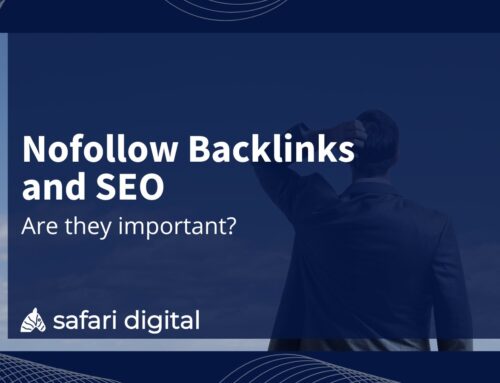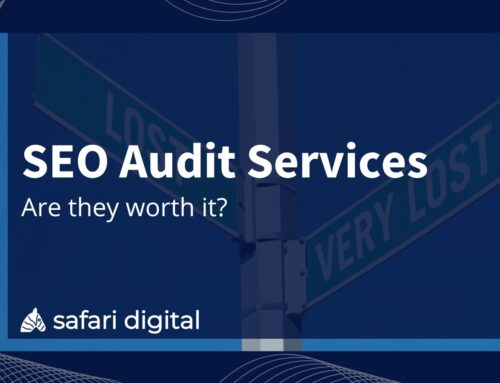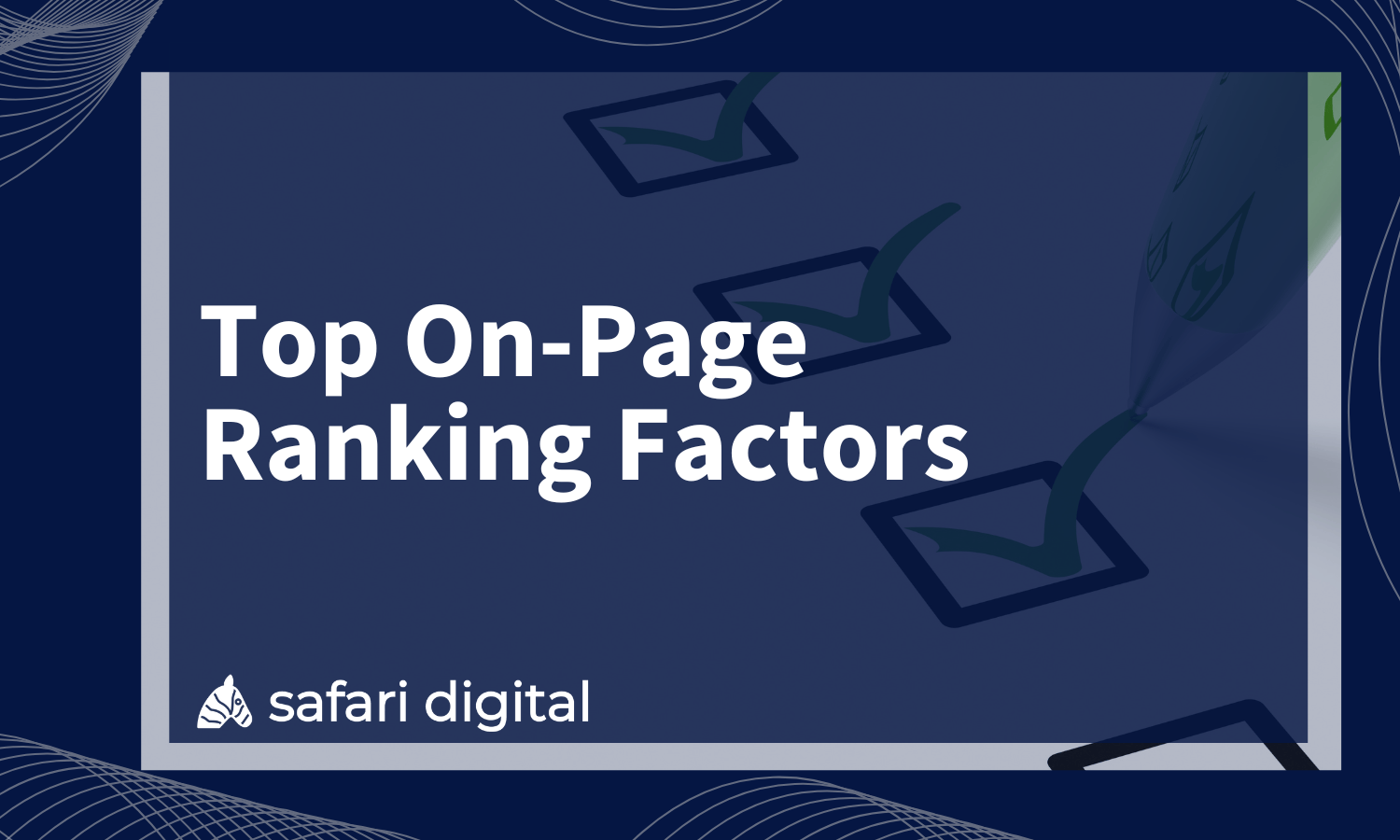
The top 7 on-page SEO ranking factors that are used to determine how websites rank in search engines in 2024.
As search engines continue to evolve, the pendulum of on-page, off-page, and technical ranking factors continues to shift.
Google (and other search engines) look at a long list of on-page ranking factors to determine how, when, and where a website appears in the search results.
Understanding all of these can seem like an impossible task. So, to make things easier, we’ve put together a list of the top 7 on-page ranking factors that you should care about in 2024.
Table of Contents
What is on-page SEO?
Before we jump into the most important on-page ranking factors for 2024, let’s start with a little bit of housekeeping.
On-page SEO, or on-site SEO as it is also referred to, is the process of optimising a web page for search engines and for users.
There are (likely) hundreds of small on-page ranking factors that come together to form a complete picture for search engines. Not all on-page ranking signals carry the same weighting. A handful of the most important on-page SEO ranking factors (which we cover in this article) are used to determine rankings.
Combined with other off-site and technical elements, search engines will use these on-page signals to determine where a page ranks in the organic search results.
1. Page Titles (Title Tags)
Page titles, meta titles, title tags – whatever you want to call them – are the titles that appear in SERPs as blue text that users click on to go to your page.
These small snippets of text are an important on-page ranking factor that can have a significant impact on where your website ranks in the search results, and how enticing they are for users to click on.
Google’s John Mueller has previously confirmed title tags as an on-page ranking factor back in 2021 when he said:
“One of the things I think is worthwhile to keep in mind is we do use titles as a tiny factor in our rankings as well. So it’s something where I wouldn’t necessarily make titles on your pages that are totally irrelevant.”
In our experience, this statement is a rather large understatement in the importance of title tags as an on-page SEO ranking factor. From our experience, we would confidently say that page titles are one of the top three on-page SEO ranking factors that SEOs need to pay very close attention to.
At the time of writing, the ideal title length is between 50-60 characters. Any longer than this and there is a good chance that it will be shortened or truncated by search engines to suit different devices.
According to the latest research, Google shortens 61% of all title tags that are specified in the HTML of the website. In most cases, Google shortens them because they are simply too long. However, for anyone that has crafted an over-optimised title, you’ll know all too well that they may also be shortened because they are overstuffed with keywords.
According to Google, there is no official limit on how long your page title can be. Google’s official stance is that title tags can be as long (or as short) as you like – they just need to provide enough relevancy to search engines and users to effectively convey the contents of the page.
2. Keywords in URL
Keywords in the URL have long been speculated as an on-page SEO ranking factor.
Back in 2016, Google’s John Mueller confirmed that keywords in a URL are (a small) ranking factor that Google uses when considering where a page ranks in the search results:
“I believe that’s a very small ranking factor, so it’s not something I’d really try to force. And it’s not something where I’d say it’s even worth your effort to kind of restructure your site just so you can include keywords in the URL.”
But is the ranking power of using your keywords in the URL actually that small? In our reckoning, John Mueller is underselling the power of using keywords in the URL.
A quick review of the search results quickly reveals that keywords in the URL are much more than a simple coincidence or loose correlation.
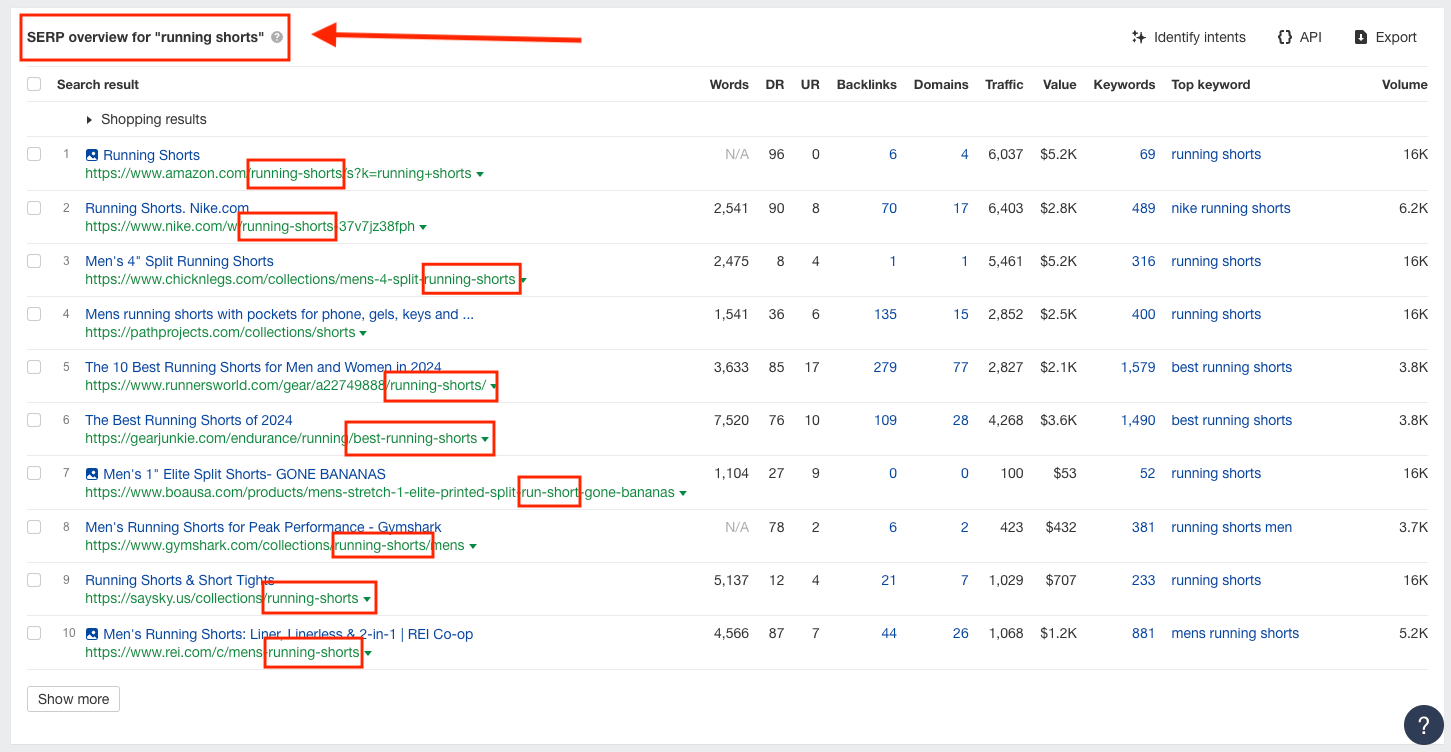
In 2021, John Mueller further reiterated the ‘small’ role that keywords play in the search ranking algorithm when he said:
“We use the words in a URL as a very very lightweight factor. And from what I recall, this is primarily something that we would take into account when we haven’t had access to the content yet. So if this is the absolute first time we see this URL and we don’t know how to classify its content, then we might use the words in the URL as something to help rank us better.”
Our thoughts on keywords in the URL as a ranking factor?
Keywords in the URL are an important on-page SEO ranking factor. So much so that we recommend reviewing key pages on a website to align them with your chosen keyword for that page. There are, of course, instances where it is worth reviewing other factors such as links to that page and current performance before making any major changes.
3. Content Quality
High-quality content is without a doubt one of the most important on-page SEO ranking factors.
But what is quality content and who is the arbitrator of what it means to publish high-quality content?
Content quality is a rather subjective term when it comes to SEO. However, a good rule of thumb when determining quality content is to figure out whether it is accurate, unique (tone and presentation), relevant, and tailored towards the needs of the reader.
Perhaps one of the most difficult aspects of content quality is that there is no official tool to measure it. Unlike all of the third-party tools which can spit out objective measurements around number of backlinks, length of content, and frequency of keyword usage, there is no tool that can determine what is and what is not quality content.
Google’s E-E-A-T acronym is sometimes (incorrectly) used as a measuring stick for content quality. E-E-A-T stands for Experience, Expertise, Authoritativeness, and Trustworthiness.
Contrary to plenty of misconceptions, E-E-A-T is not a ranking factor in Google’s search ranking algorithm. Instead, it’s a component of Google’s Search Quality Rater Guidelines which are used to assess the expertise of content. Google’s Search Quality Rater Guidelines have multiple chapters – E-E-A-T is just one of them. With that said, writing content that meets the E-E-A-T guidelines can only be a good thing.
So, what exactly is quality content?
More so than ever before, creating high-quality content is about writing for the needs of your audience. In years gone by, there was an argument to be had that keyword density, keyword stuffing, and a myriad of other factors could somehow transcend ‘quality’ content as a ranking factor.
TLDR – the golden roles when measuring quality content:
• Content should be engaging
• Content should be accessible and easy to read
• Content should match the search intent
• Written for users – not for search engines
• Timely and up-to-date information
• Trustworthy with accurate reporting of facts and information
Today, it’s about writing content for your readers – not for yourself and not for search engines. Content should be accessible, engaging, and accurately reflect what users expect to find on that page. Meeting search intent, provide credible viewpoints, and reporting timely, accurate information is essential.
4. Content Relevancy
Content relevancy is a reflection of how well content matches a search query and the intent behind that search query.
When it comes to on-page SEO ranking factors, content relevance is a big one.
While similar to the notion of content quality that we mentioned just above, content relevance is a reflection of how well content is able to match what the user was looking for when conducting a search.
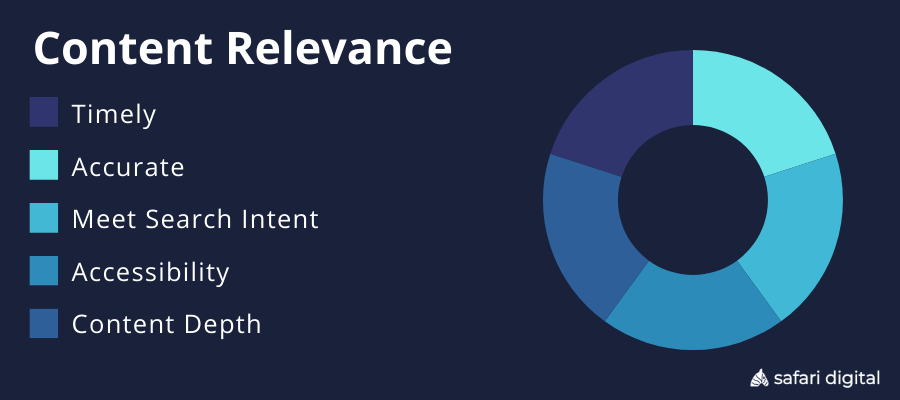
There is a common belief that longer content = better rankings. But increasingly we are seeing that this is not the case. In years gone by, simply writing more content was seen to be a golden ticket to higher search rankings. Today, smart publishers know that segmenting information and providing highly relevant results is a more effective way to boost SERP visibility.
Relevant content understands the needs of your target audience, effectively tailors’ content towards what they are searching for, and focuses on providing comprehensive answers that don’t require them to search anywhere else to complete the picture.
TLDR – golden rules for content relevancy
• Don’t try to do too much with a single web page
• Focus on meeting specific needs and providing in-depth information around a specific topic area
• Ensure that content is timely and (for evergreen content) is maintained and up to date
• Stick to what you know. When publishing content, stay in your lane and ensure that the content that you publish is within your niche. I.e. if you are a pet food company, don’t start posting nutrition advice for humans – stick to what you know.
• Make sure that page title, headings, text, and media (images and video) are all relevant.
5. Internal Links
Internal links are hyperlinks that go from one page to another page on the same website.
As far as on-page SEO goes, internal links are an extremely effective (albeit misunderstood) way to improve your on-page SEO. There’s a range of reasons why internal links are considered to be one of the most valuable on-page ranking signals, but here’s a short list that you should be aware of:
• They help search engines to find and index new and relevant content
• They help users to find relevant resources and reading materials on your website
• They convey site hierarchy and context to search engines
• They pass internal authority between pages and convey an internal content hierarchy
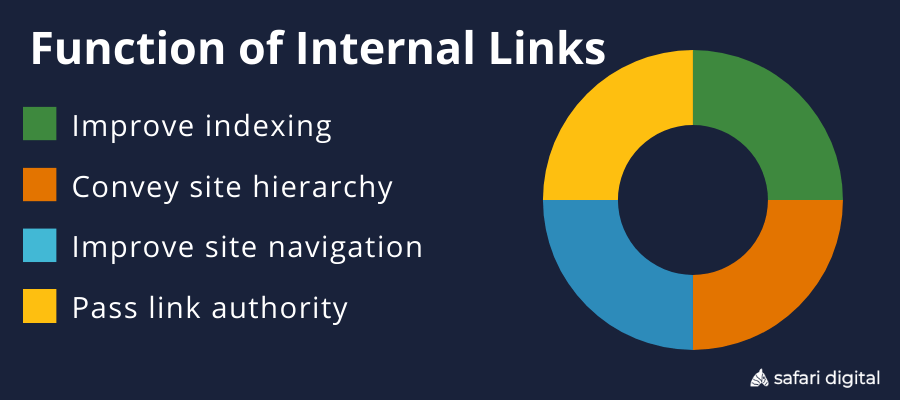
Not all internal links are the same. They come in a range of different forms, including:
• Menu/navigational links
• Footer links
• Sidebar links
• Contextual in-text links
• HTML sitemap links
• Related content/product links
Just like users, Google (and other search engines) follow internal links to find new content on websites. Just like external links, posts and pages with more internal links are generally seen to be a more important piece of the puzzle for search engines.
When you think about internal links, it’s best to consider whether the internal resource that you are linking to is going to provide value to visitors. Particularly for in-text links, make sure that the content that you are linking to provides depth and related information that is likely to be of interest to your readers.
6. Structured Data
Structured data in a list of on-page SEO ranking factors may look a little bit out of place – but just hear us out on this one.
In a tweet from back on the 2nd April 2018, John Mueller said the following about structured data as an on-page SEO ranking factor:
“There’s no generic ranking boost for SD usage. That’s the same as far as I remember. However, SD can make it easier to understand what the page is about, which can make it easier to show where it’s relevant (improves targeting, maybe ranking for the right terms). (not new, imo)”
Effectively saying that on its own, structured data was not considered to be an on-page ranking factor. However, leaving it to people to speculate whether providing more context for targeting would be enough to warrant using structured data.
In an SEO Office Hours Q&A back on the 21st January 2022, John Mueller provided an answer to a user asking about whether or not schema information should be used to communicate information about various office locations and contact points for a multi-location business provided the following answer:
“So if you’re using this structured data to get some specific feature in the search results, then I would put that on those individual pages where you want that feature to be used. If you’re just using the structured data as a way of giving Google a little bit more information, because maybe Google will find this information useful, then that’s something where I’d say like, it’s a very, very small thing. And whether or not you do it or don’t do it, is probably not going to change the overall perception of a website.”
We might be grasping at straws a bit on this one. But it could certainly be said that structured data is an on-page SEO ranking factor that is worth considering. If Google is directly saying that structured data helps with targeting and understanding the context of a web page, then it’s hard to imagine it not having a positive correlation to on-page performance.
7. Heading Tags (H-Tags)
Header tags are an HTML styling element used by browsers to determine how a piece of text will be displayed on the web page.
Just like chapters of a book, heading tags are intended to break up the content on a web page and provide an easy-to-skim structure that users can use to find relevant information on a page.
When it comes to on-page SEO, H-tags are a commonly misunderstood piece of the puzzle. Given that we have H1, H2, H3, H4, H5, H6 to choose from – it’s not hard to see where things can become a little blurred.
So, how do you write H-tags that enhance your on-page SEO? Here are some golden rules to follow for heading tag best practices:
1. Make sure that heading tags accurately reflect the context that follows.
2. Ensure that heading tags contain your target keywords (where it makes sense).
3. Follow a logical hierarchy for heading tags on the page.
4. Where possible, use only one H1 tag on the page. According to Google, there is no limit to the number of H1 tags that you can use on a page, but we recommend sticking to one. Pages with seven H1s start to look a little unhinged.
5. Make your heading tags engaging – remember that heading tags aren’t just for search engines, they are intended to be engaging for your readers.
6. Plan out your heading tags before you start writing – this makes it easier to plan out and structure your content accordingly.
H-tags are helpful for search engines and for users alike. For search engines, heading tags provide context about the layout and information of a web page. To users, heading tags make it easy to skim a page, find information, and determine the context of a web page – making that information more accessible and easier to read.




